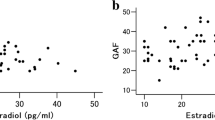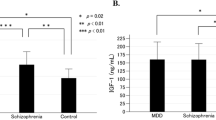Summary
With the help of an analytical path structure model (causal analysis) the aim of the study was to elucidate further, in female patients with various depressive disorders, some correlations of causal interdependencies between changes both in basal secretion of anterior pituitary hormones and in their responses to the (combined) insulin tolerance test (ITT) with extraneous factors—such as age, deviation from ideal body weight (in percentage), severity of depression and score in the Newcastle Scale (NCS)—that may influence these abnormalities.
In various depressive subgroups the strength of influence and the different importance of deviation from ideal body weight and basal growth hormone (GH) concentration (as exclusion criteria) for their neuroendocrine reactivity in the combined ITT was shown.
The hypothesis that cortisol hypersecretion may be the primary disturbance and the other possible neuroendocrine changes such as blunted GH, cortisol and TSH responses to stimuli in some depressive patients all may be secondary to the (elevated) cortisol level could not be corroborated.
The endogenous mono- and bipolar subtypes of major depressive disorders showed intimate connections between the various neuroendocrine functional systems and the above mentioned extraneous factors resulting in a narrowed variability and a stronger coupling in the reactivity of these hormonal functional systems, a condition which can be seen as analogous to experimental results at the psychophysiological level in these nuclear groups of depressed patients, whose psychopathological state is also characterized by similar limitations in their “degree of freedom” (Heimann).
Zusammenfassung
Mittels eines pfadanalytischen Strukturmodells werden bei unterschiedlichen Subgruppen depressiver Patienten mögliche kausale Zusammenhänge zwischen verschiedenen — im kombinierten Insulin-Hypoglykämie-Test überprüften — hormonellen and neuroendokrinen Funktions-systemen dargestellt unter Berücksichtigung der Kontrollvariablen: Alter, Ernährungszustand, Depressionstiefe und Score in der Newcastle-Scale.
Die differente Bedeutung des Ernährungszustandes und der basalen Wachstumshormon-Konzentration für die neuroendokrine Reaktivität im kombinierten Insulin-Hypoglykämie-Test — und damit ihre Wertigkeit als Ausschlußkriterien —wird für die verschiedenen depressiven Subgruppen aufgezeigt. Die Hypothese, wonach alle bei bestimmten Depressiven nachweisbaren neuroendokrinen Dysfunktionen als sekundäre Phänomene der (erhöhten) Cortisol-Basalwerte aufgefaßt werden könnten, findet duch die hier vorgelegten Befunde keine genügende Bestätigung.
Die Kerngruppe der endogen mono- und bipolaren Depressionen weist eine enge Verknüpfung der überprüften neuroendokrinen Funktionssysteme — vor ahem über die Cortisol-Basalwerte — untereinander und mit den überprüften Kontrollvariablen auf, so daß sich eine eingeengte Variationsbreite der Reagibilität in den funktionell miteinander zusammenhängenden Systemen ergibt, ein analoger Befund zu Ergebnissen auf der psychophysiologischen Ebene.
Similar content being viewed by others
Literatur
Beck AT, Ward CH, Mendelson M, Mock J, Erbaugh JH (1961) An inventory for measuring depression. Arch Gen Psychiatry 4:53–63
Berger M, Doerr P, Lund R, Bronisch T, Zerssen D von (1982) Neuroendocrinological and neurophysiological studies in major depressive disorders: Are there biological markers for the endogenous subtype? Biol Psychiatr 17:1217–1242
Blalock HM (1971) Causal models in the social sciences. Illinois Press, Chicago
Brown GM, Seggie JA, Chambers JW, Ettigi PG (1978) Psychoneuroendocrinology and growth hormone: A review. Psychoneuroendocrinology 3:131–153
Carney MWP, Roth M, Garside RF (1965) The diagnosis of depressive syndromes and the prediction of E.C.T. response. Br J Psychiatry 111:659–674
Carroll BJ (1969) Hypothalamic-pituitary function in depressive illness: Insensitivity to hypoglycaemia. Br Med J 3:27–28
Casper RC, Davis JM, Pandey GN, Garver DL, Dekirmenjian H (1971) Neuroendocrine and amine studies in affective illness. Psychoneuroendocrinology 2:105–113
Checkley SA (1980) Neuroendocrine tests of monoamine function in man: Review of basic theory and its application to the study of depressive illness. Psychol Med 10:35–53
Czernik A (1982) Zur Psychophysiologie und Neuroendokrinologie von Depressionen. Springer, Berlin Heidelberg New York
Czernik A (1984a) Neuroendokrinologie. In: Battegay R, Glatzel J, Pöldinger W, Rauchfleisch U (Hrsg) Handwörterbuch der Psychiatrie. Enke, Stuttgart, S 299–304
Czernik A (1984b) Problematik des Insulin-Hypoglykämietestes als Hilfsmittel in der Depressionsdiagnostik. In: Hopf A, Beckmann H (Hrsg) Forschungen zur Biologischen Psychiatrie. Springer, Berlin Heidelberg New York Tokyo, S 183–191
Czernik A (1984c) Möglichkeiten und Grenzen neuroendokrinologischer Funktionsdiagnostik. In: Wolfersdorf M, Straube R, Hole G (Hrsg) Depressiv Kranke in der psychiatrischen Klinik. Roderer, Regensburg, S 270–281
Czernik A, Kleesiek K (1980) Insulin sensibility and pituitary-hormone secretion in the course of depressive syndromes. Prog Neuropsychopharmacol [Suppl] 120
Czernik A, Steinmeyer EM (1984) Path analysis as a causal model for evaluating the importance of biological parameters in depression. 14th CINP Congress, June 19–23, Florence, Italy
Czernik A, Kleesiek K, Steinmeyer EM (1980) Änderungen neuroendokrinologischer Parameter im Verlauf von Depressionen. Nervenarzt 51:662–667
Dahlem Konferences (1983) Angst J (ed) The origins of depression: Current concepts and approaches. Springer, Berlin Heidelberg New York, p 300 and p 398
Endo M, Endo J, Nishikubo M, Yamaguchi T, Hatotani N (1974) Endocrine studies in depression. In: Hatotani N (ed) Psychoneuroendocrinology, Mieken 1973. Karger, Basel, pp 22–31
Extein I, Pottash ALC, Gold MS (1981) Relationship of thyrotropin-releasing hormone test and dexamethasone suppresion test abnormalities in unipolar depression. Psychiatr Res 4:49–53
Frantz AG, Rabkin MT (1975) Effects of estrogen and sex difference on secretion of human growth hormone. J Clin Endocrinol Metab 25:1470–1480
Gruen PH, Sachar EJ, Altman N, Sassin J (1975) Growth hormone responses to hypoglycaemia in postmenopausal depressed women. Arch Gen Psychiatry 32:31–33
Hamilton M (1960) A rating scale for depression. J Neurol Neurosurg Psychiatry 23:56–62
Heimann H (1978) Changes of psychophysiological reactivity in affective disorders. Arch Psychiatr Nervenkr 225:223–231
Heimann H (1979) Auf dem Wege zu einer einheitlichen psychophysiologischen Theorie depressiver Syndrome. Prax Psychother Psychosom 24:281–297
Heimann H (1980) Psychophysiologische Aspekte in der Depressionsforschung. In: Heimann H, Giedke H (Hrsg) Neue Perspektiven in der Depressionsforschung. Huber, Bern Stuttgart Wien, S 85–87
ICD und Glossar psychiatrischer Krankheiten (1975) Degkwitz R, Helmchen H, Kockott G, Mombour W (Hrsg) Springer, Berlin Heidelberg New York
Kahn CR, Goldfine ID, Neville DM, Meyts P de (1978) Alterations in insulin binding induced by changes in vivo in the levels of glucocorticoids and growth hormone. Endocrinology 103:1054–1066
Kendler KS, Davis KL (1977) Elevated corticosteroids as a possible cause of abnormal neuroendocrine function in depressive illness. Commun Psychopharmacol 1:183–194
Kirkegaard C, Carroll BJ (1980) Dissociation of TSH and adrenocortical disturbances in endogenous depression. Psychiatr Res 3:253–264
Koslow SH, Stokes PE, Mendels J, Ramsey A, Casper R (1982) Insulin tolerance test: Human growth hormone response and insulin resistance in primary unipolar depressed, bipolar depressed and control subjects. Psychol Med 12:45–55
Krieger DT, Glick SM (1972) Growth hormone and cortisol responsiveness in Cushing's syndrome. Am J Med 52:25–40
Lantigua RA, Streck NF, Lockwood DH, Jacobs LS (1980) Glucocorticoid suppression of pancreatic and pituitary hormones: Pancreatic polypeptide, growth hormone, and prolactin. J Clin Endocrinol Metab 50:298–303
Loosen PT, Prange AJ (1980) Thyrotropin releasing hormone (TRH): A useful tool for psychoneuroendocrine investigation. Psychoneuroendocrinology 5:63–80
Loosen PT, Prange AJ (1982) Serum thyrotropin response to thyrotropin-releasing hormone in psychiatric patients: A review. Am J Psychiatry 139:405–416
Loosen PT, Prange AJ, Wilson TC (1978) Influence of cortisol on TRH-induced TSH response in depression. Am J Psychiatry 185:244–246
Merimee TF, Fineberg SE (1971) Studies of the sex-based variation of human growth hormone secretion. J Clin Endocrinol Metab 33:896–902
Mueller PS, Heninger GR, McDonald RK (1969) Insulin tolerance test in depression. Arch Gen Psychiatry 21:587–594
Nathan RS, Sachar EJ, Asnis GM, Halbreich U, Halpern FS (1981) Relative insulin insensitivity and cortisol secretion in depressed patients. Psychiatr Res 4:291–300
Revenstorf D (1980) Faktorenanalyse. Kohlhammer, Stuttgart
Rubin RT, Poland RE (1983) Neuroendocrine function in depression. In: Angst J (ed) The origins of depression: Current concepts and approaches. Dahlem Konferences 1983. Springer, Berlin Heidelberg New York Tokyo, pp 205–220
Sachar EJ, Finkelstein J, Hellman L (1971) Growth hormone responses in depressive illness. I. Response to insulin tolerance test. Arch Gen Psychiatr 25:263–269
Sachar EJ, Frantz AG, Altman N, Sassin J (1973) Growth hormone and prolactin in unipolar depressed patients: Responses to hypoglycaemia andl-dopa. Am J Psychiatry 130:1362–1367
Seibel HD, Nygreen GT (1972) Pfadanalyse. Ein statistisches Verfahren zur Untersuchung linearer Kausalmodelle. Z Sozialpsychol 3:5–12
Zerssen D von (1976a) Depressivitätsskala. Manual. Beltz, Weinheim
Zerssen D von (1976b) Die Befindlichkeitsskala. Manual. Beltz, Weinheim
Zerssen D von, Berger M, Doerr P (1984) Neuroendocrine dysfunction in subtypes of depression. In: Shah NS, Donald AG (eds) Psychoneuroendocrine dysfunction. Plenum Publishing Corporation, New York, pp 357–382
Author information
Authors and Affiliations
Additional information
(Vorstand: Prof. Dr. W. Klages)
Rights and permissions
About this article
Cite this article
Czernik, A., Steinmeyer, E.M. Kausalanalytische Untersuchungen zur Darstellung neuroendokriner Parameter im kombinierten Hypoglykämietest bei depressiven Subgruppen. Eur Arch Psychiatr Neurol Sci 235, 110–118 (1985). https://doi.org/10.1007/BF00633482
Received:
Issue Date:
DOI: https://doi.org/10.1007/BF00633482
Key words
- Combined insulin tolerance test (ITT)
- Major depressive disorder
- Neuroendocrine dysfunctions
- Path analysis




